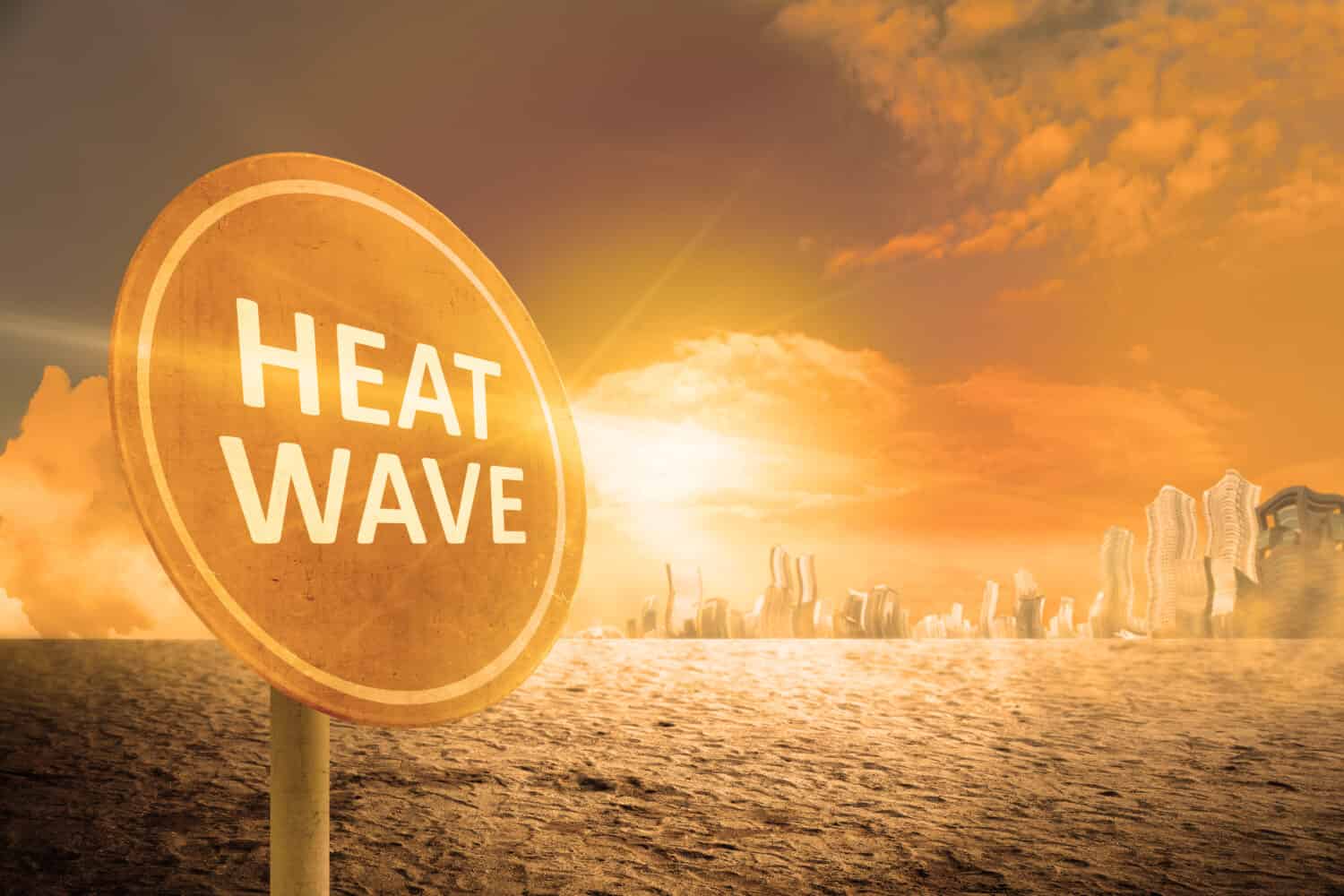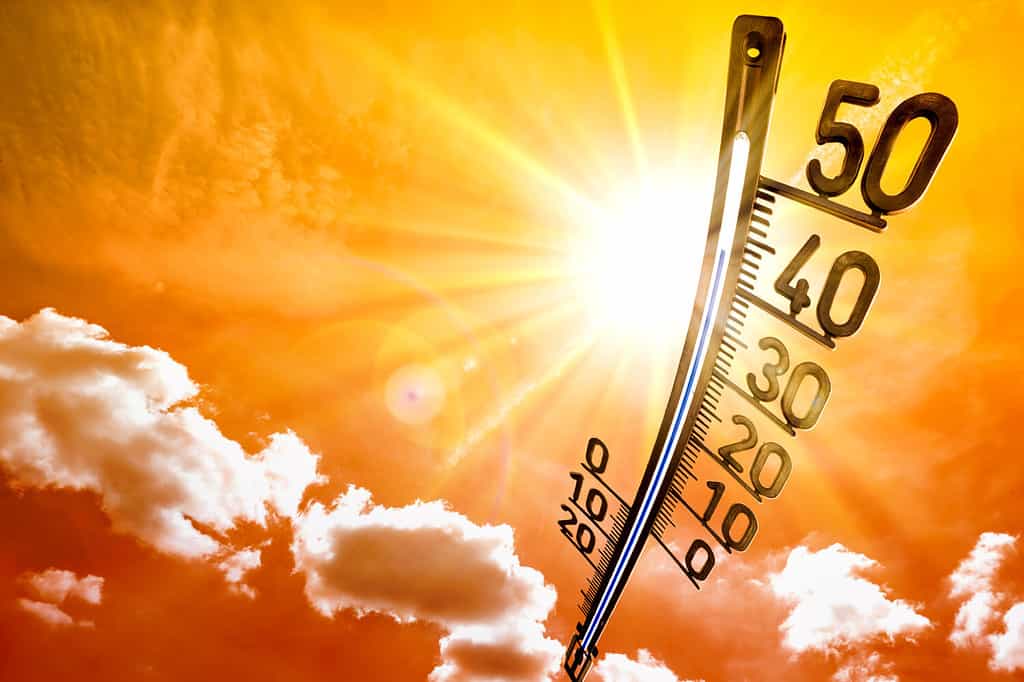There’s a fiery heatwave sweeping the Southwest U.S., and it’s threatening to keep things extremely hot from 2023 to 2027. According to experts, there’s a 98% chance that one of the next five years will claim the title of the hottest year ever recorded. Global temperatures are breaking heat records left and right. Prepare yourself for the hot weather ahead. In this article, we’ll explore some of the likely causes behind the heatwave, its impact, and tips for staying safe in extreme heat. What should you know about the epic heatwave hitting the planet? Follow along to find out.
1. What Is a Heatwave?

A heatwave is above-average hot weather that lasts over two days.
©leolintang/Shutterstock.com
A heatwave is above-average hot weather that lasts for more than two days. Heatwaves can occur with or without high humidity. High humidity can make the weather feel even hotter, making a dangerous situation even worse. All heatwaves have the potential to cover large areas, exposing a high number of people to hazardous heat conditions. Thankfully, there are a lot of things you can do to protect yourself like staying indoors, staying hydrated, and keeping up to date on heat warnings.
2. Epic Heatwave Sweeping Southwest U.S.

About 11% of the U.S. population lives in an area where extreme heat poses a risk.
©GetFocus/Shutterstock.com
The recent heatwave in the southwestern United States has affected over 115 million people with heat warnings. Approximately 36.9 million individuals, about 11 percent of the U.S. population, are living in areas where the heat poses significant risks. States like Nevada, Oklahoma, and California are also experiencing oppressive heat. In parts of the Southern Plains, temperatures are soaring up to a blood-boiling 115°F.
3. Why Is It So Hot?

A heat dome, a high-pressure system trapping warm air, is contributing to the epic heatwave.
©VladisChern/Shutterstock.com
Experts predict this year could become the hottest on record. But why? There’s not just one cause contributing to the increased temperatures. Instead, the heatwave is the result of several situations, including climate change and a massive heat dome.
Over 90 million U.S. people face a heat dome expansion, causing California’s first extreme heatwave of the year. A heat dome is a high-pressure system that traps warm air, making the weather really hot and dry. This means there’s less rain and more sunlight, making the Earth’s surface heat up a lot.
Alongside the heat dome, climate change is also causing the heatwave. Situations such as this are precisely why so many people are coming up with amazing ideas to tackle climate change. Innovators, scientists, and passionate individuals have been working tirelessly to develop sustainable technologies, promote renewable energy sources, and implement eco-friendly practices. From innovative solar energy solutions and wind farms to advancements in electric transportation and reforestation efforts, the potential for combating climate change is promising. However, there’s still a long road ahead.
4. Role of Climate Change in Heatwaves

The Earth’s average temperature is much higher than it was between 1850 to 1900.
©leolintang/Shutterstock.com
Climate change is also making these extreme heat events more common all over the world. In 2022, the Earth’s average temperature was already about 1.15°C higher than it used to be between 1850 and 1900. Fewer human-made activities released greenhouse gases into the atmosphere during that earlier period. The fact that the temperature increased by 1.15°C means our planet is getting warmer, and human activities are a big reason for this warming.
Greenhouse gas emissions, which are gases released into the atmosphere from human activities, are causing extreme heat waves to occur more frequently and become even hotter than they would have been naturally. Over the years, the frequency of heat waves has significantly increased. In the 1960s, there were about two heat waves per year on average, but now there are around six heat waves per year. Recent evidence suggests that the rise in heat waves has been greater than these numbers indicate.
5. Lifesaving Tools
To stay safe during heatwaves, use these lifesaving tools, which offer safety and health information for excessive heat:
Heat.gov will take you to the National Integrated Heat Health Information System, also known as NIHHIS. You’re covered whether it’s learning about Excessive Heat Warnings, Excessive Heat Watches, or Heat Advisories. NIHHIS raises the bar for our capacity to deal with extreme heat and paves the way for better communication. The goal of this platform is simple: to educate and safeguard as many people as possible from the dangers of extreme heat. It’s incredibly helpful to get up-to-date on heat and health information.
Using heat tracking tools is easy. Just a glance to the left of the site, and you’ll see real-time data for things like extreme heat advisories and warnings. There are also interactive heat tools that let you engage with current and potential future heat conditions. This way, you can get a head start in understanding where dangerous heat conditions may lurk in the future.
The CDC Heat and Health tracker also helps you have a clearer understanding of current weather, making it easier to respond effectively when the heat turns extreme. It’s an invaluable tool for local communities to prepare and respond to extreme heat events. The tracker helps you navigate the impacts of extreme heat on your county, identify populations at risk, and discover vital response resources.
The data provided by the tracker paints a vivid picture of the heat challenges we face. As of August 2023, the tracker displays the expected number of days in the next month that will reach or exceed a dangerous level of heat based on climatological norms. These forecasts rely on the National Oceanic and Atmospheric Administration’s Climate Prediction Center’s probabilistic outlook of changes in average maximum temperatures expected in the next month.
6. Excessive Heat Warning vs. Watches
The National Weather Service Forecast offers several different products or warnings when it comes to heat. When you hear about an excessive heat warning, it means dangerous heat is coming within 12 hours. It’s going to be really hot, like 105°F or even higher, for at least 2 days, and the nights won’t cool below 75°F.
Now, if you hear about excessive heat watches, it’s a heads-up that a heatwave might happen in the next 24 to 72 hours. They’re unsure about the exact timing, but you should be prepared just in case. It’s a warning to brace yourself for hot weather.
There’s also the heat advisory. This one is issued when it’s going to be at least 100°F for a couple of days, and the nights aren’t going below 75°F.
Finally, excessive heat outlooks mean there might be a big heatwave in the next 3 to 7 days. This gives you time to be aware and get ready. It helps everyone plan and take precautions early. An epic heatwave is no joke, take every precaution possible to stay safe in extreme heat.
7. Staying Safe in Extreme Heat

Stay safe in extreme heat by staying indoors with air conditioning and fans.
©DimaBerlin/Shutterstock.com
Staying safe in extreme heat is a matter of life and death. Since 1979, heat has claimed the lives of around 11,000 people in the United States. Thankfully, there are a lot of measures you can take to stay safe.
Here’s what you can do to protect yourself:
- Dress smart
- Stay hydrated
- Eat easy-to-digest meals
- Stay in air-conditioning
Wear clothes you can feel cool in; it’s even better if they have UPF protection. Minimize direct exposure to the sun to prevent sunburn, which can reduce the body’s ability to dissipate heat.
Stay hydrated. Drink plenty of water; always have a water bottle handy. As for meals, choose light, cool, and easy-to-digest foods like fruits or salads. Carry food in coolers or with ice packs to prevent spoilage in hot weather.
Take advantage of air conditioners. Spend time in air-conditioned places like libraries. While you’re there, find out what events are going on to pass the time. A lot of libraries still have weekly educational programs, even when it’s an epic heatwave.
If you don’t have air conditioning, do whatever you can to make your environment cool. You can use fans to draw in cooler air and keep airflow going. Avoid activities that will heat things up, like using the oven. Take cool baths or showers to reduce body temperature.
Eat light foods. When you eat heavy meals, your body heats up to digest them. Instead, stick to fresh fruits, veggies, cereal, and other light foods.
Do you have an outdoor job? Rest in the shade during breaks. Be careful not to overdo it, heat sickness is a serious condition. New workers or those returning after a week or more should gradually increase their workload and take more frequent breaks. Listen to your body, and realize when it’s time to quit.
Basically, when it’s super hot outside, slow down. Avoid doing tough activities during the hottest parts of the day. And listen to your body overheating. Some people are more vulnerable to the heat, like kids, older folks, those with medical conditions, pregnant women, and babies, so they should always stay in cool places.
8. Who’s Most Vulnerable to Extreme Heat?

Since their bodies aren’t developed to handle extreme heat, children are vulnerable to heatwaves.
©riggleton/Shutterstock.com
Elderly individuals, especially those over 65 years old, are at higher risk during heatwaves. Their bodies find it harder to regulate temperature, and heat exposure can cause severe health issues. Older people with pre-existing chronic diseases face even greater risks due to their physical limitations. Also, social isolation is a concern that needs attention during heatwaves. There has to be a safe measure for conducting check-ins during extreme weather events. Talk to loved ones about how you’ll keep in touch to ensure everyone’s safe during extreme heat events.
9. Expect Changing Rainfall Patterns
Heatwaves and climate change can also change rainfall patterns, impacting precipitation intensity and frequency. When the planet warms, the oceans experience higher temperatures, leading to increased evaporation of water into the atmosphere. Certain regions, like the Sahel, northern Europe, Alaska, and northern Siberia, are anticipated to experience increased rainfall from 2023 to 2027 compared to previous periods. On the other side of things, the Amazon and parts of Australia might face reduced rainfall. These precipitation shifts can significantly impact agriculture, water resources, and the overall environment.
The way rain falls also matters a lot. When there’s gentle rain that lasts a long time, the water slowly soaks into the ground. But when there’s a heavy storm, the water rushes over the surface, taking the soil with it. There are also short but intense rain bursts, happening over and over again, which can also cause soil to break loose and wash away. And when this happens, it can change the shape of the land and affect how water flows across the landscape forever.
10. Heatwaves Cause Decreased Productivity
Excessive heat significantly reduces people’s working capacity, leading to decreased productivity and economic output. Looking ahead, in Europe, it is projected that by the 2060s, extreme heat could cause annual average economic damages surpassing 1.14% of the continent’s GDP. Understanding and addressing these challenges cannot be overstated, as they have immense implications for our societies and ecosystems. Thankfully, there’s a lot of ongoing research to understand the problem better.
Research in India has provided some good insights. In industries that rely heavily on manual labor, such as cloth weaving and garment manufacturing. In India, productivity decreases by up to 4% for every degree rise above 80.6°F. Researchers also found heat affects labor-intensive industries and causes absenteeism even in highly automated workplaces. For each one-degree increase in the ten-day average temperature, the probability of worker absence rose by up to 5%. But it’s not just India; high temperatures are linked to lower economic productivity worldwide. Hot temperatures worldwide put a damper on economic productivity. Who can work efficiently in scorching heatwaves? Staying focused and meeting performance standards is tough when the sun’s blazing.
Heatwave History: Extreme Heat Event of 2012

The heatwave of 2012 broke over 8,000 high-temperature records.
©Guenter Albers/Shutterstock.com
Heatwaves aren’t a new phenomenon. In the summer of 2012, an epic heatwave hit the eastern United States from late June to early July, breaking more than 8,000 temperature records and resulting in numerous deaths. Temperatures soared, with many places surpassing 100°F and even reaching above 110°F.
The scorching temperatures were so intense that roads even buckled in Chicago. Extreme heat expands the road surface, pushing it up at cracks and seams. Algonquin Road took a hit, with buckling occurring near Ela Road in Hoffman Estates and Elgin Road in Algonquin. The buckling was so bad on Columbus Drive officials had to close down the street during the famous Taste of Chicago event. Chicago O’Hare International Airport saw its highest temperatures during the heatwave, reaching 103°F on July 5th and 6th. Chicago experienced three consecutive days of 100°F temperatures, tying historical records from 1911 and 1947.
Middle Tennessee endured nearly daily temperatures around or above 100°F from June 28 to July 8. Nashville and Crossville recorded their highest-ever temperatures on June 29, hitting 109°F and 102°F, respectively. The heat didn’t stop there. Rockford had its warmest day on July 7, reaching 105°F, the highest since 1936, and faced four consecutive days of 100°F temperatures.
This heatwave wasn’t just limited to these areas; it was part of a larger pattern of extreme heat and drought across the United States in June and July 2012. By early July, 56% of the contiguous U.S. was experiencing drought, the highest percentage in the 12-year record of the U.S. Drought Monitor. The drought led to devastating fires, scorching over 1.3 million acres across the country, particularly impacting the Western states.
Final Thoughts on Epic Heatwave
There you have it. The ins and outs of the big heatwave hitting the southwestern United States caused more than 115 million people to face heat warnings. How can you stay safe when the temperatures are scorching hot? The National Weather Service says we should stay hydrated, be in cooler rooms, avoid direct sunlight, and check on vulnerable people, especially older folks who live alone. Extreme weather events are a time to come together as a community and look out for one another. Together we can help save lives, and even save the planet!
The photo featured at the top of this post is © Ed Connor/Shutterstock.com
Thank you for reading! Have some feedback for us? Contact the AZ Animals editorial team.







